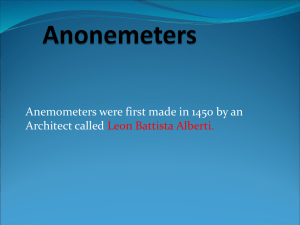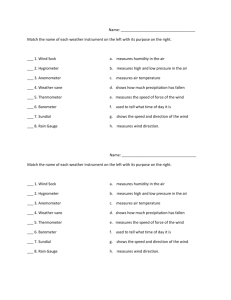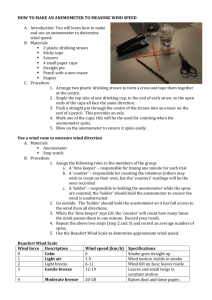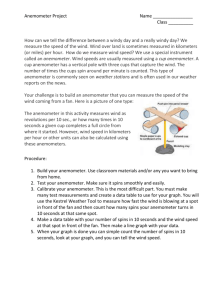Wind Group: Data Acquisition and Analysis Final Report
advertisement
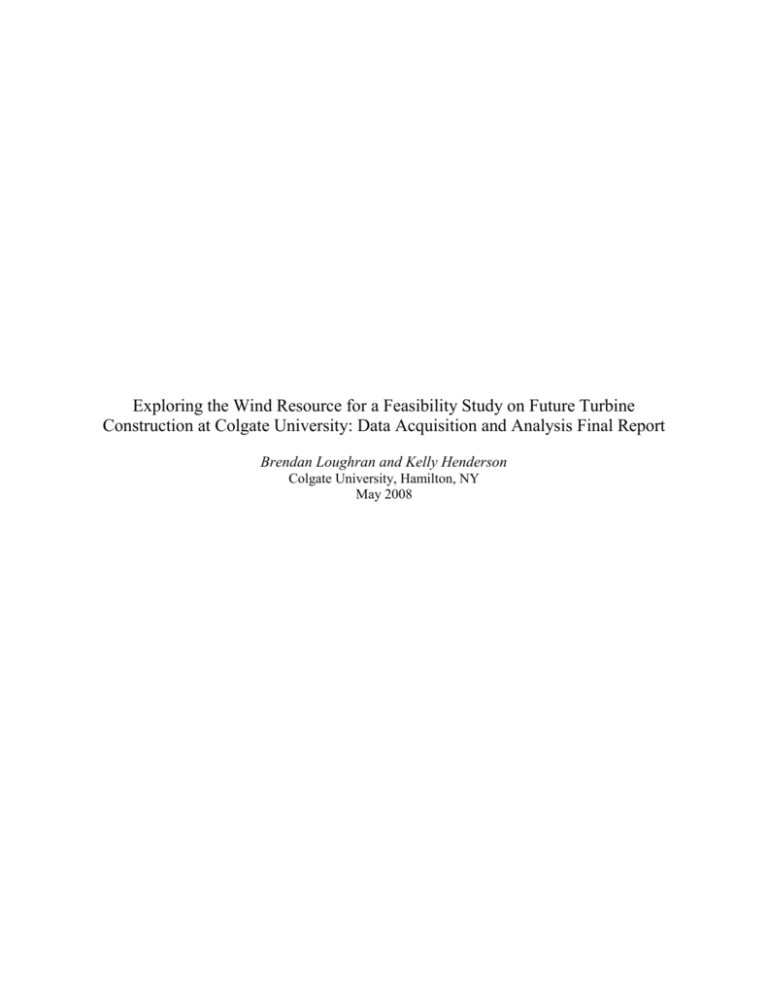
Exploring the Wind Resource for a Feasibility Study on Future Turbine Construction at Colgate University: Data Acquisition and Analysis Final Report Brendan Loughran and Kelly Henderson Colgate University, Hamilton, NY May 2008 Page 2 1. Introduction As part of Colgate University’s Environmental Studies Seminar entitled “Interdisciplinary Investigation of Environmental Issues: Alternative Energies,” a group of student geographers, economists and physicists formed a wind energy group with the overarching goal of investigating Colgate’s potential to commit to a program devoted to constructing a wind turbine on or off Colgate’s landholdings. Within the wind energy group, our “Data Analysis and Acquisition” subgroup was responsible for (1) acquiring a professional-grade anemometer, (2) erecting the anemometer at a test site, (3) taking wind speed and direction data from the established site and (4) modeling the data set to a third party’s data for the same logging period to facilitate further analysis. The most common instrument used for wind resource assessment is the cup anemometer; an instrument that measures wind speed using three or four cups that rotate around a vertical axis. A wind vane, a fin connected to a vertical shaft, is used to measure wind direction. The anemometer’s wind speed data can be used to calculate the average cubed speed, which can then yield maximum and minimum power and Annual Energy Output (AEO) figures for a turbine of a given rotor diameter. Directional data is useful in turbine siting and also in comparing assessment data to a third party source while allowing for the ability to make corrections in a modeling algorithm due to obstructions that do not fall outside of international weather station siting standards. 2. Anemometer Specifications In our search for the correct anemometer, we wanted a professional-grade device that could take both directional and speed data while also having data logging capabilities. In looking for a professional-grade anemometer, we needed a device that met the accepted error standard of Page 3 Figure 1: Our HOBOware Wind Speed/Direction Smart Sensor. ±3% or less deviation from true wind velocity at speeds greater than 10mph1. After researching various options, we decided to purchase Onset Computer Corporation’s HOBO Wind Speed / Direction Smart Sensor (Fig 1). The sensor is marketed as “ideal for a broad range of wind monitoring applications,” including wind power site evaluation2. The monitoring station also accepts up to four sensors, which allows for the possibility of purchasing additional Smart Sensors for measuring other weather parameters or additional identical Wind Sensors for wind profiling at multiple heights. The anemometer calculates instant wind velocity based on cup revolutions accumulated every three seconds and logs wind speed by calculating the average over the specified logging interval. Directional data is given using the vector wind direction accumulated every three seconds. The value given in the data set is the average calculated from the sum of the vector components over the logging interval. The HOBO sensor fit with industry “Wind Resource Assessment Handbook: Fundamentals for Conducting a Successful Monitoring Program” Prepared by AWS Scientific, Inc. for NREL, p. 35. http://www.nrel.gov/wind/pdfs/22223.pdf 2 “Onset Computer Corporation Introduces Wind Monitoring Station.” BNET Business Network. June 3, 2004. http://findarticles.com/p/articles/mi_m0EIN/is_2004_June_3/ai_n6053639. 1 Page 4 standards for a professional-grade anemometer with an accuracy of ±3% from 38 to 67 mph and ±4% from 67 to 105 mph3. 3. Device Siting Standards Siting is optimal when the prevailing wind speed is perpendicular to a ridge, when the location is the highest elevation in the given area and when the site is in an area where wind can funnel (Fig.2). Wind speed data is the most important indicator in determining an area’s wind energy resource. Measurements at different heights are ideal as they allow for a calculation of wind shear, or how wind speed varies with height above ground in a given area. The National Renewable Energy Laboratory measures at heights of 40 meters, 25 meters and 10 meters; 10 meters (33 feet) being the universally standard meteorological measurement height (or 10 meters above the forest canopy, if ground cover deems it necessary)4. This height standard is also specified in the Citizen Weather Observer Program’s handbook, which states that “obstructions should be more than 7 ft (2m) below the anemometer or at least 45 ft (20m) from the base” of the anemometer tower5. CWOP provides a guide for individuals who maintain personal weather stations and share their data with the general public. Information from such personal weather stations is made available on websites like WeatherUnderground.com, which we used as our secondary third party data source in our data comparison (to be discussed later in this paper). Weather station siting standards also state that obstructions should be more than 7 ft (2m) below the anemometer or at least 45 ft (20m) from the base of the anemometer tower. The international standard for wind measurement specifies that average values should be calculated on a tenminute basis6. 3 HOBO Sensor Specifications, TheDataLoggerStore.com. http://www.microdaq.com/occ/hws/windspdir.php AWS Scientific, Inc. for NREL (see 1. above), p. 20 5 “Citizen Weather Observers Program (CWOP):Weather Station Siting, Performance, and Data Quality Guide.” March 8, 2005. http://home.comcast.net/~dshelms/CWOP_Guide.pdf 6 AWS Scientific, Inc. for NREL (see 1. above), p. 20 4 Page 5 (a) (b) Figure 2: Windier locations are likely to be (a) ridges oriented perpendicular to the prevailing wind direction and (b) locations where wind can funnel.7 4. Site Specific Details (Bonney Hill, Hamilton, NY) For our test site, we chose to set up the anemometer on the roof of Professor Ian Helfant’s house at coordinates N 42◦50’130” W 075◦31’004” and an altitude of 1520 feet. These measurements were obtained using a portable GPS device. We ordered 5 meters (16.4 feet) of welded steel tubing along with the device itself to use as a mounting mast. The base of the mast was secured vertically (using metal clamps) along the length of the television antenna, which was already firmly attached to the chimney of the Helfant’s house. The completed assembly also required a grounding kit consisting of a length of copper wiring attached to the bottom of the mast that ran down the side of the house and terminated in a copper rod driven into the ground. Wiring also ran down the side of the house, from the sensor to the data logger, and into the house where the sensor was permanently attached to an indoor PC. Our site selection was ideal for a test site since our data could be constantly checked and retrieved due to the proximity of the computer to the sensor. The system we ordered, however, also has the capability of storing data and uploading the information to a laptop at a later date, should the anemometer site be located far from an available computer. The total height of the anemometer (including the height of the house) came to approximately 35 feet above ground level, which made for a measurement altitude of 1555 feet (474 meters). The altitude is important for a calculation of the air density, 7 AWS Scientific, Inc. for NREL (see 1. above), p. 17. Page 6 which is then used to calculate the power output of specific turbine models. Air density (in kg/m3) is found using the equation: gz P RT 0 RT where P0 = the standard sea level atmospheric pressure (101kPa); R = the specific gas constant for air (287 J/kg·K); T = the air temperature in degrees Kelvin (= degrees Celsius +273); g = the gravitational constant (9.8 m/s2); z = the site elevation above sea level (m). Using the average temperature for the month of April in Hamilton, NY of 9.9ºC (282.9ºK) given by Weather Underground and our site elevation of 474 meters, this yields a site air density of 0.987 kg/m3 (0.0616 lb/ft3). We will use this value later in our turbine specific power calculations. The Helfants’ house was an acceptable test site as it was easy to obtain permission to construct our tower there and as the house is constructed in a fairly open area on top of Bonney Hill (Fig. 3). However, there were two error factors to take into consideration when analyzing the site for its wind resources. First of all, the fact that the mast was erected on top of an established structure allows the wind data to be influenced by eddies created by wind flowing over the building. (insert standard for mounting on top of a house here). Secondly, a large tree stands to the northeast, next to the house and above the height of the cups of the anemometer (Fig. 4). The CWOP handbook provides a standard for judging the quality your weather station siting which includes a rating system for anemometer placement based on a one-to-ten scale (Fig. 5). Our siting at the Helfants’ house earns a rating of 7 out of 10 on this scale. Page 7 Figure 3: Topographic map of the immediate vicinity of Bonney Hill. The red dot identifies the location of Professor Helfant's house. Page 8 Figure 4: Our Anemometer set-up. In this picture you can see the obstructive tree that we took into account in our data analysis. Page 9 Figure 5: Optimal weather station siting table. Our anemometer falls under the categorization in row j., which yields an anemometer performance rating of 7 out of 10.8 5. Logging Program Information We began logging our data on March 25th at 6:41:44 pm and we logged continuously until April 27th at 9:15:16 am with two exceptions. The anemometer froze from March 27th at 7:51 pm to March 28th 10:33 am and from March 28th at 3:00 pm until March 29th at 1:06 pm, creating a gap in our data. Higher grade anemometers prevent this error in freezing climates by heating the rotational shaft. The second gap in our data lasted from April 4th at 9:05:09 pm until April 9th at 7:28:36 pm when our data logger reached capacity in its data storage and stopped recording instead of looping over the earliest recorded data. This was our error as we did not set the anemometer to loop after reaching logging capacity when we set it up. Before this major gap in the data, we were logging on five second intervals and after the gap we switched to ten second intervals. In the future, to make data analysis easier, we recommend logging at the industry 8 (table)Determining Optimal Sensor Siting for your Location. CWOP Guide (see 6. above), p. 31. Page 10 standard of once every ten minutes. This will yield a data set ready for comparison to sources such as the personal weather station KNYHAMIL1 posting its data on weatherunderground.com, which logs its data every five or 10 minutes (somewhat inconsistently—this will be discussed later). The data is handled through the Onset HOBOware 2.5 software for data logger management, data graphing and data analysis. The HOBOware software presents the data in graphical and tabular form, recording gust speed, wind speed, and wind direction for each logged time interval. The data can either be manipulated in this program to display averages and maximums over a specified interval, or it can be exported to an Excel document where the data can be analyzed and errors can be corrected beyond the capabilities of the software (or at least, beyond our understanding of the capabilities of the software). Our month’s worth of data logging yielded approximately 450,000 data points, which we exported to 11 total Excel documents. The standard minimum monitoring duration for wind speeds is one year with more years recommended, if possible9. While the NREL states that a year is usually sufficient to determine variability between years through comparison to data sources (from airports, for example), they do not condone the extrapolation that we are attempting. Going against all sources’ recommendations, we are taking our test data within a period of one month. Given the restrictions of needing data to analyze within the time constraints of a semester-long class, we are trying to see if anemometer data taken over a period of time under a year can be reliably compared to a third party data source to extrapolate an estimate for the average yearly wind speed in the anemometer site. In order to do this, we had to search for a reliable source as close to Hamilton, NY as possible that had records of at least daily wind speed averages over the past year. Preferably the site would also have similar terrain features to those at the site of our anemometer. 9 AWS Scientific, Inc. for NREL (see 1. above), p. 20 Page 11 6. Third Party Data Sources We first tried to identify third party sources by going with the recommendation of most of our source readings. We contacted every airport closer than and including Syracuse Airport. This list also includes Oneonta County Airport (Griffiss Airport, Rome), Hamilton Municipal Airport and Warren Eaton Airport (Norwich). None of these airports had wind speed data archived over the past year. We also looked to weather website services such as the National Ocean and Atmospheric Administration (NOAA) and weatherunderground.com. We were unsuccessful with the NOAA but our attempts to use the Weather Underground data for comparison will be described in detail below. In addition, we also discovered two anemometers on campus, one on top of the new greenhouse attached to the Robert N. Ho Science Center and one on Wynn Hall. We successfully retrieved information on daily wind speed averages and maximums from the anemometer on Wynn Hall, which is directly connected to the campus Energy Management System and adds a wind chill calculation into the system10. We used the daily averages from the heating plant as our primary comparative data set in analysis, to be discussed below. 7. Data and Analysis Once the anemometer data run was complete, we compiled the data to observe wind velocities and compare to known third party data sets. Because of the small time intervals selected (5 sec per point for first logging run, 10 sec per point for second run), we had an extremely large set of data points. In order to reduce the data into a manageable number, we averaged the intervals to five minute increments. The data was then averaged for daily averages (to compare with the intervals available in the third party data) and overall averages. The anemometer total average came to 4.491867079 mph. 10 Data from the heating plant was sent from Colgate heating plant staff member Brian Belden. Page 12 Next, we considered the third party data from both the Colgate University heating plant anemometer and the Hamilton weather station sponsored by Weather Underground. The data from the heating plant anemometer was recorded as a daily average. Records extend from the present day (4/29/08) to roughly a year prior (5/1/07). Over this time, we found an average of 4.5301676 mph. For the Weather Underground information, we took daily averages of the data available online for the time our anemometer was operating. Here we find an average (over our program period) of 0.946153846 mph. From a comparison of these averages, a trend can be seen between the three data sets (Fig. 6). First of all, the averages from the heating plant and the Bonney Hill anemometer are relatively close. We can largely consider these two sites as similar. However, when comparing the Weather Underground averages to heating plant and Bonney Hill anemometer averages, we notice a large discrepancy. The slower velocities recorded by the Weather Underground averages are definitively due to a difference in elevation, as this station is at a lower elevation (1134 ft) compared to the heating plant and the Bonney Hill anemometer11. In addition, we suspect a large obstacle interfering with the Weather Underground station, due to the large difference in wind velocity values and the overall slow wind velocities recorded. In this vein, we next consider any obstacles that would have affected the Bonney Hill anemometer data points. The first known obstacle that we observe is a large tract of data where the logger froze at zero for the wind velocity and gust velocity. This is first observed from 3/27/08 19:51:44 - 3/28/08 10:33:09 and was caused by the anemometer cups freezing in place. After going through the anemometer data, the cups froze at only two points during the data 11 WeatherUnderground.com, information on personal weather station KNYHAMIL1, located in Hamilton, NY. http://www.wunderground.com/weatherstation/WXDailyHistory.asp?ID=KNYHAMIL1 Page 13 Wind Velocity 30 Wind Velocity 25 20 15 10 5 0 3/23/08 0:00 3/28/08 0:00 4/2/08 0:00 4/7/08 0:00 4/12/08 0:00 4/17/08 0:00 4/22/08 0:00 4/27/08 0:00 5/2/08 0:00 Date/Time Figure 6: Deep blue points are the Helfant house data 5 minute interval averages, light blue points are the daily Helfant house data averages, purple points are the heating plant daily averages, and yellow points are the Weather Underground daily averages. logging. Removing these points, while the best way to estimate the zeroes’ effect on the overall average, was too tedious given the large number of points. Rather, the points at zero in the freeze were counted and then multiplied for the number of freezes that occurred. Overall, the number of points frozen at zero was estimated at 40,000. This can be expressed as percent of point affected: 8.88%. Thus the overall average wind velocity ought to be increased by this amount to account for the freeze. Here we find the average of the Bonney Hill anemometer to be 4.86246664 mph. The other obstacle to consider is the large tree in the Northwest direction to the Bonney Hill anemometer (Fig. 7). This tree is roughly 40 degrees from the North and is less than its own height from the base of the anemometer. Therefore the tree affects the wind recorded in the same direction. The prevailing wind direction is in the 113 degree direction (with North as 0 degrees). Thus, if the tree is located at 113 degrees it would affect the recorded wind velocity Page 14 Figure 7: Diagram of anemometer with respect to prevailing wind direction and obstacles. 100% (Note: here we make the assumption that wind coming in the direction of the tree is almost completely shielded). Conversely, if the prevailing wind came from completely upwind of the tree, the wind velocity records would not be affected at all. Normalizing these conditions we use the following equation to find the affect of the tree on the wind velocity: % int erference cos 2 Considering this correction, we find the tree to be affecting 29.24% of our data. By coincidence, this is very close to the AWEA estimate of a 7 out of 10 rating of our anemometer placement (3 out of 10 of our points need adjustment/ see Figure 5). With this adjustment accounted for, we find the final wind speed average of our data to be 6.871160753 mph. Page 15 8. Output Calculations The power and annual energy output (AEO) equations provided below are those given by the Department of Energy’s “U.S. Consumer’s Guide to Small Wind Electric Systems,” and used for a rough estimate of the respective values using a single value for a site’s average annual wind speed12. Power (kW ) 1 kCp AV 3 2 where Cp ρ A V k = Maximum power coefficient, ranging from 0.25 to 0.45, dimensionless = Air density, lb/ft3 = Rotor swept area, ft2 or π D2/4 (D is the rotor diameter in ft) = Wind speed, mph = 0.000133 A constant to yield power in kilowatts and AEO(kWh / year ) 0.01328D 2V 3 where D = Rotor diameter, feet V = Annual average wind speed, mph Since we have access to data that covers smaller averaging intervals (we used daily intervals), we get more accurate results for our power and energy calculations if we introduce an average of values for wind speed cubed calculated for each wind speed value record in our averaging interval. These more accurate equations are: Power (kW ) n 1 3 kC p A vi 2n i 1 “U.S. Consumer’s Guide to Small Wind Electric Systems,” DOE. March 2005. http://www.eere.energy.gov/ windandhydro/windpoweringamerica/pdfs/small_wind/small_wind_guide.pdf. (p. 9-10) 12 Page 16 AEO(kWh / year ) 0.01328 2 n 3 D vi n i 1 where n = the number of records in the averaging interval; and vi3 = the cube of the ith wind speed (mph) value These calculations were used in the spreadsheet on page 17 to calculate the power and energy potential for individual small turbine models. 9. Small Wind Turbine Models As part of our research, we also compiled a list of potential small wind manufacturers based on a list of recommended manufacturers and models provided by AWEA and certified as meeting the standards of “recommended business practices”13. The information on turbine models’ rotor diameters and power ratings were obtained from each respective manufacturer’s website. If the University were to consider building one of the following models, we recommend cross-listing this compilation with New York State’s Energy Research Development Authority’s (NYSERDA) Power Naturally program’s list of small wind incentives14. Using our extrapolated average annual cubed wind speed, we calculated the minimum and maximum power capacity of each turbine as well as the AEO. The spreadsheet below shows three different AEO calculations for each of the following three cubed average wind speed values: (1) the raw data average; (2) the data corrected for the intervals when the anemometer was frozen; and (3) the data corrected for both the frozen intervals and the presence of the tree in the Helfants’ yard. “Small Wind Turbine Equipment Providers” AWEA. http://www.awea.org/smallwind/smsyslst.html Find this list of incentives on NYSERDA’s Power Naturally website: http://www.powernaturally.org/ Programs/Wind/incentives.asp 13 14 Figure 8: Small wind turbine manufacturers/models and their respective power and energy outputs. Page 17 Page 18 These specific calculations are used to discuss the hypothetical case study in the following section. The same spreadsheet can be adjusted for a different site by replacing the average cubed wind speed and the air density values so they represent the new location15. 10. Future Siting Scenario If we imagine that the Bonney Hill location is acceptable for the construction of a wind turbine (the exact location of the anemometer—on Professor Helfant’s house—is not acceptable for wind turbine construction since all manufactures strongly recommend against erecting a turbine on the roof of a structure), the most promising scenario would lead to the construction of a small (20 Watts to 100 kiloWatts) turbine whose energy output was not connected to the grid, but was connected directly to the house and that ideally provided for all the house’s electricity needs16. Based on official energy statistics on the Northeast Census Region from the Energy Information Administration, the average annual residential consumption in the state of New York is approximately 8,000 kWh17. Due to our AEO calculations for the individual turbine models on page 17, the ideal turbine for this case study would be Entrgrity’s EW15 model. After comparing these findings to the GIS analysis of the wind potential of Colgate landholdings done by the geographers in our working group, we would like to erect our anemometer on the Bewkes property, located in the Township of Lebanon next to Seymour Pond. In order to set up our anemometer at this new site, we need to construct a guyed tower that will extend at least the standard 33 feet off the ground on its own (that is, without the added height offered by the Helfants’ house at our first location). Also, ideally, data will be taken at this location for a full year. We will construct the anemometer in the middle of an open field, so 15 For an electronic copy of this spreadsheet for use with new anemometer sites, contact Professors Ian Helfant, Beth Parks, or Bob Turner. 16 DOE “Consumer’s Guide to Small Wind” (see 9. above), p. 4. 17 Last published report “Consumption in US Households by Northeast Census Region.” 2001. http://www.eia. doe.gov/emeu/recs/recs2001/ce_pdf/enduse/ce1-9c_ne_region2001.pdf Page 19 obstructions will no longer be a contributing factor in our data analysis. We are currently hesitant to conclude anything regarding the accuracy of extrapolating an annual average wind speed from a smaller period of data collection due to the large number of error factors that contributed to our collected data. Pending permission to construct on the proposed site, this project will begin in late May to early June 2008. Only after annual data is collected at the Bewkes site and after we have done a similar analysis to a subset of the data set will we be able to draw conclusions regarding the accuracy of intrannual extrapolation.

